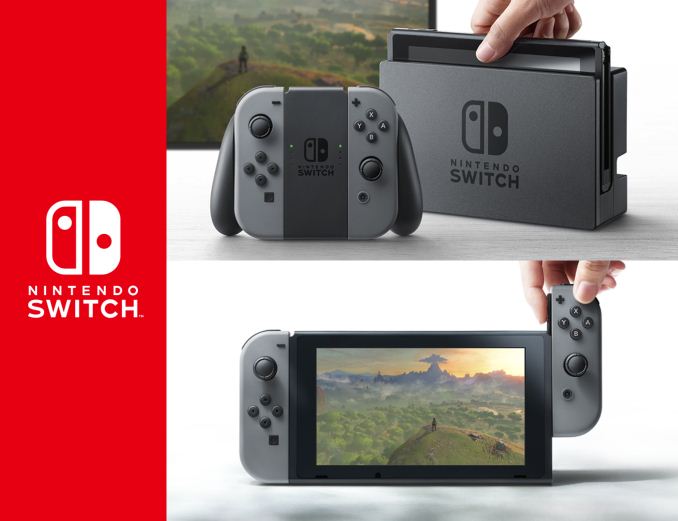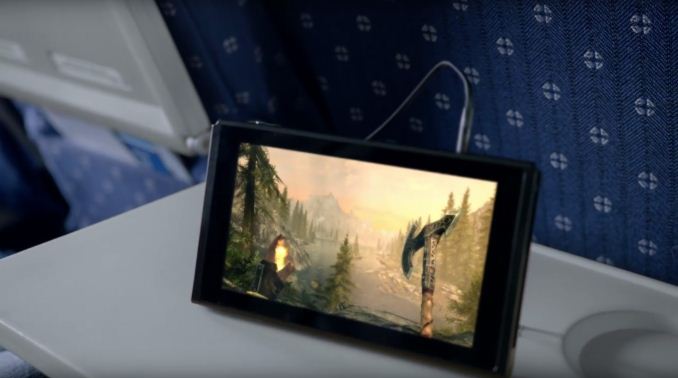Nintendo Announces Switch Portable Gaming Console - Powered by NVIDIA Tegra
by Ryan Smith on October 20, 2016 4:25 PM EST
Earlier today Nintendo took the wraps off of their next generation console, Switch. Formerly known by the codename NX, the Switch is the successor to both Nintendo’s portable DS and set top Wii console lines, utilizing a portable, tablet-like unit that can be docked to behave like a set top console. Today’s announcement, in the form of a 3 minute trailer, is meant to tease the console ahead of its full launch in March of 2017.
While I’ll skip the commentary on the console’s unusual design – dedicated gaming sites can offer better context – I wanted to dive into the hardware in the Switch. Given that this was a teaser, I was not expecting a reveal of any of the hardware specifications of the console, and indeed neither Nintendo’s teaser video nor their related press release made any mention of the underlying hardware. However shortly after the reveal went live, NVIDIA sent out an email to the press and posted a blog of their own. As it turns out, while today is still just a teaser, in some ways we’re already getting more information about the console than in any previous generation of Nintendo’s hardware.
In their blog post, NVIDIA confirmed that they would be providing the underlying SoC for the console. As this is still ultimately a teaser, NVIDIA’s own details are light, but their announcement confirms that it’s a custom version of their Tegra SoC. Curiously, no mention of the CPU core in that SoC is mentioned. However as it’s a Tegra, something ARM-based is the logical (if not only) choice. And on the GPU side, as you’d expect, they’re using a GPU based on one of NVIDIA’s existing GPU architectures, though the company isn’t specifying if it’s Pascal or Maxwell (I’d assume Pascal, but consoles are known for their long development cycles).
Otherwise, as far as specifications go that’s all we get for now. Though as NVIDIA is supplying a whole SoC there are obviously many more parts to the package that we’ll hopefully learn about in the near future. More CPU and GPU details are obviously the most interesting aspect – does the Switch SoC use Denver CPU cores? – but there’s also the matter of memory bandwidth, WiFi support, and the many other functional blocks that make up an SoC.
For NVIDIA, this is the first console hardware win for the company since the PlayStation 3, which launched in 2006. In the set top console market, AMD has since provided the GPU (and often, the CPU) for the most recent generation of consoles. Otherwise NVIDIA has never had a 3rd party portable console win, primarily because both Nintendo and Sony developed their respective SoCs internally for the 3DS and Vita.
In fact, given that Nintendo previously did much of their portable console development work internally, this is a notable shift for how the company operates. The 3DS was essentially a custom SoC combining multiple ARM11 (ARMv6) CPU cores with an OpenGL ES 1.1 generation GPU from the little-known Digital Media Professionals (DMP). So this is the first time Nintendo has contracted out their SoC needs to a third party in such a visible fashion. I’m actually a bit surprised that NVIDIA is even allowed to talk about their involvement at this point in time, given Nintendo’s historical focus on secrecy.
Though all of this also helps to underline just how big a jump in technology the Switch is from the 3DS. On the CPU side alone it’s reasonable to assume we’re looking at CPU design in the neighborhood of 4.x DMIPS/MHz, versus ARM11’s approximate 1.3 DIMPS/MHz rate, so IPC will have increased significantly, never mind an increase in frequency. Meanwhile on the GPU side, Nintendo is going from a GPU that didn’t even have a programmable GPU pipeline (i.e. shaders) to a fully modern GPU, essentially catching up on a decade of mobile GPU development in a single bound. Given that the console has to work as both the company’s portable and set top consoles, Nintendo has opted to use far more modern tech than their traditionally conservative designs.
Finally, without reading too much into a 5 paragraph announcement, there is one other interesting nugget of information in NVIDIA’s blog post that further shows just how deep the NVIDIA/Nintendo relationship is going here. Along with providing the SoC, NVIDIA also has a major stake in the development of the console’s API and middleware. While NVIDIA presumably isn’t developing the entire software stack, they make special note of the fact that they are providing a new “lightweight” API, NVN, for the console. NVIDIA is also providing middleware in the form of “a revamped physics engine, new libraries, advanced game tools and libraries” and “custom software for audio effects and rendering” which sounds a great deal like NVIDIA having brought over major parts of their GameWorks SDK, including the PhysX physics simulation libraries and VRWorks Audio library.
In any case, it will be interesting to see how this plays out over the next few months. The mobile world has changed significantly since the 3DS was launched in 2011, something that the Switch’s design makes obvious. Nintendo has gone in a very different direction than either their console rivals or the smartphone market that is always threatening to encroach on mobile consoles, and that’s reflected in both the unusual dual-mode console and the hardware inside of it.












109 Comments
View All Comments
briand095 - Thursday, October 20, 2016 - link
well wonder how long they will stand behind N like they do the tab makersJoeyJoJo123 - Thursday, October 20, 2016 - link
A solution looking for a problem.Ironchef3500 - Thursday, October 20, 2016 - link
totally agreedCaedenV - Thursday, October 20, 2016 - link
This is absolutely the future... the problem is that Windows phone is already there, and Android will be there in another year or two (and iOS is lost in the woods, but they might get there eventually). What need is there for a $3-400 console when everyone is socially required to buy a $4-700 cell phone that does this exact same thing? And more... and better...Yojimbo - Thursday, October 20, 2016 - link
One thing is certain and that is that a cell phone can't do the exact same thing. How is a cell phone going to be able to do this? It doesn't have the input devices and it doesn't have the processing power. The screen is probably also too small. Is it going to easily hook up to a television and power a game of Skyrim? Of course cell phone gaming will be a big thing, but that doesn't mean there isn't a market for more involved mobile gaming. I think we'll have to wait and see what they achieve. You're predicting they get lost between mobile gaming and home gaming. They obviously are trying to bridge the gap between them. Gaming is about interaction. Cell phones, in terms of games, allow for very limited forms of interaction.LukeTim - Friday, October 21, 2016 - link
Smartphones also don't have the same tools and support for game developers... Nor can you realistically sell a full $60/£50 experience on the app store.Wolfpup - Friday, October 21, 2016 - link
Yeah. I'm buying new 3DS games probably every month or two that offer real experiences worth the $40 or whatever dollars, that just blow away most of the trash available on iOS/Android, even if 3DS is about like an iPhone 1.Drumsticks - Thursday, October 20, 2016 - link
How so? The prospect of bringing Breath of the Wild on the airplane or a road trip, or sticking Pokemon on the big screen, are pretty clear, and big, draws for me and plenty of others around the internet.JoeyJoJo123 - Thursday, October 20, 2016 - link
>The prospect of bringing Breath of the Wild on the airplane or road trip.This is the new Nintendo console gimmick of this generation. The majority of game console owners use their devices to play games on their home TV, and they want a turnkey solution to getting "good" graphical fidelity and gameplay from the comfort of their home. Consider the overwhelming popularity and success of the PS4 compared to the Xbox One and Wii U this generation; It doesn't have the tablet mode that the Wii U had. It didn't have the fancy Cortana/Kinect features that Xbox One had. It was just a refined system, the bread and butter and nothing else of what the majority of console buyers want in their system.
I only play PC games and I only own a Wii U from this generation. But I've been getting pretty disillusioned with Nintendo's choice in new gimmicks starting with the Wii. I truly think the GameCube was the last good Nintendo console.
This is the Wii U's tablet, untethered from a 15 foot radius. Tell me, how often do people play from the tablet screen, rather than the TV display? Do you think people would be suddenly more inclined to leave the TV after this, too? Don't gaming laptops already fill a niche in playing high-fidelity PC games, untethered from your home, for years? What exactly does this achieve that other form factors haven't already?
>Or sticking Pokemon on the big screen.
You can blame GameFreak for refusing to develop a Pokemon game for home consoles, for that. Besides, this has been available since the Super Nintendo, with the Gameboy Player cartridge. Then again in the Gamecube, with the Gameboy Advance Player base. Also available with the many ways you can screen capture or emulate DS/3DS consoles and then feed that to a TV.
dragonsqrrl - Thursday, October 20, 2016 - link
"This is the Wii U's tablet, untethered from a 15 foot radius. Tell me, how often do people play from the tablet screen, rather than the TV display? Do you think people would be suddenly more inclined to leave the TV after this, too?"I don't really see the conflict. I don't get the impression they're trying to compete with or threaten the set top console experience. If you're at home or a setting with comfortable access to a large display, of course you'll use it over the tablet. From what I've seen the intent is simply to give users who want 'that' experience more options and flexibility, while compromising on performance as little as possible.